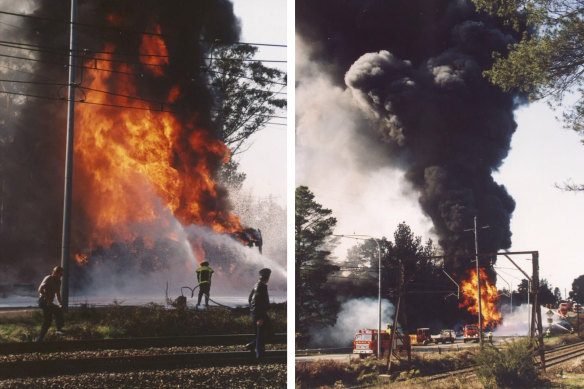By Ben Cubby and Carrie Fellner
Two gardeners working for the Blue Mountains Council, Andrew Moyle and Andrew Watson, were on their way to work 32 years ago when they saw a petrol tanker veer onto the wrong side of the road in front of them.
The tanker, carrying 40,800 litres of petrol, tipped and hit a barrier beside the road – a notorious black spot where the Great Western Highway bends to cross over the railway line at Medlow Bath on Wednesday, September 23, 1992. Flames began to engulf the truck’s cabin, where experienced driver Peter Law was trapped.

Firefighters battle the petrol tanker crash at Medlow Bath in 1992. Test results suggest the fire may be a cause of the PFAS contamination.Credit: Facebook
“We got out and raced over,” said Moyle, who helped kick in the truck’s shattered windscreen to free Law.
“Once he got out we all just got out of there as quickly as we could,” he told the Herald at the time. “The truck was starting to cook. It was a matter of minutes. Once we got about 100 metres away, up she went.”
Trees were singed 40 metres away, the metal guardrail melted, and a secondary explosion blew a firefighter seven metres down a bank. Incredibly, no-one was seriously hurt.
Now new evidence has put the 1992 fireball and frantic efforts to put it out at the centre of an investigation into the contamination by “forever chemicals” that has shut two dams and put the state’s drinking water supplies under unprecedented scrutiny.
Independent tests on water that drains directly down from the crash site into Adams Creek to feed Medlow Dam have revealed the presence of synthetic PFAS chemicals at 3.4 micrograms per litre – more than 40 times the current safe drinking water guidelines.
The most prominent of the PFAS family of chemicals found near the crash site is PFOS – a component of the firefighting foam used in huge quantities to quell the petrol tanker blaze.
More than 400 litres of PFOS-rich, fire retardant foam was thought to have been used at the site as crews rushed in from Blackheath, Katoomba, Leura and Mount Victoria.
Coupled with earlier water samples which show little PFAS contamination upstream in Adams Creek, the new tests suggest the toxic foam may have entered the water table at the crash site and stayed to pollute Lake Medlow, and by extension much of the Blue Mountains drinking water network, for up to 32 years.
“The idea that we’ve probably been drinking contaminated tap water for many, many years is really concerning to people,” said environmental campaigner and Katoomba resident Jon Dee.

Environmental campaigner Jon Dee organised water tests on behalf of the Blue Mountains community.Credit: Glenn Hunt
Dee said the community had funded its own water tests, which were undertaken to professional standards by Western Sydney University water scientist Ian Wright and processed at an accredited laboratory, Envirolab, in an attempt to pinpoint the source of the contamination.
“We had to get these tests done because we found ourselves in a situation where Water NSW and Sydney Water can’t tell us how the PFAS contamination got there, when it happened, and how long we’ve been drinking contaminated water,” Dee said.
Water authorities and the state government have repeatedly said drinking water in the Blue Mountains is safe because water with elevated PFAS levels from Medlow Dam and Greaves Creek passes through a filtration plant before it reaches taps. The Medlow and Greaves Creek dams were disconnected from the water supply system in August after the high PFAS levels were discovered.
Dee said he didn’t accept the government’s assurances, pointing out that PFAS levels in the dams would be well above proposed new Australian drinking water guidelines that were announced on Monday and may come into force next year.
“We feel that there has been a total lack of transparency. Four months ago, we knew nothing about it. How much more is going to come to light? It seems that there was no testing because they weren’t interested in finding out the results.”
Water NSW said it was undertaking soil and water tests across the entire catchment but had also identified Adams Creek as an area for “targeted investigations”.
The agency was “working with multiple government organisations including the Rural Fire Service and NSW Fire and Rescue to explore historical land use and incidents,” a spokesperson said.
It had tested hundreds of soil and water samples so far, and was posting regular updates about water quality tests on its website to allay the concerns of residents.
Wright said the results of the new water tests were strikingly similar to those found during independent tests commissioned by the Herald, despite heavy rainfall in the intervening period.
“I had expected far more diluted results,” said Wright. He said more groundwater and soil testing needed to be done, but the results suggested flows from near the crash site may have been bringing PFAS into Medlow Dam for decades.
Get to the heart of what’s happening with climate change and the environment. Sign up for our fortnightly Environment newsletter.